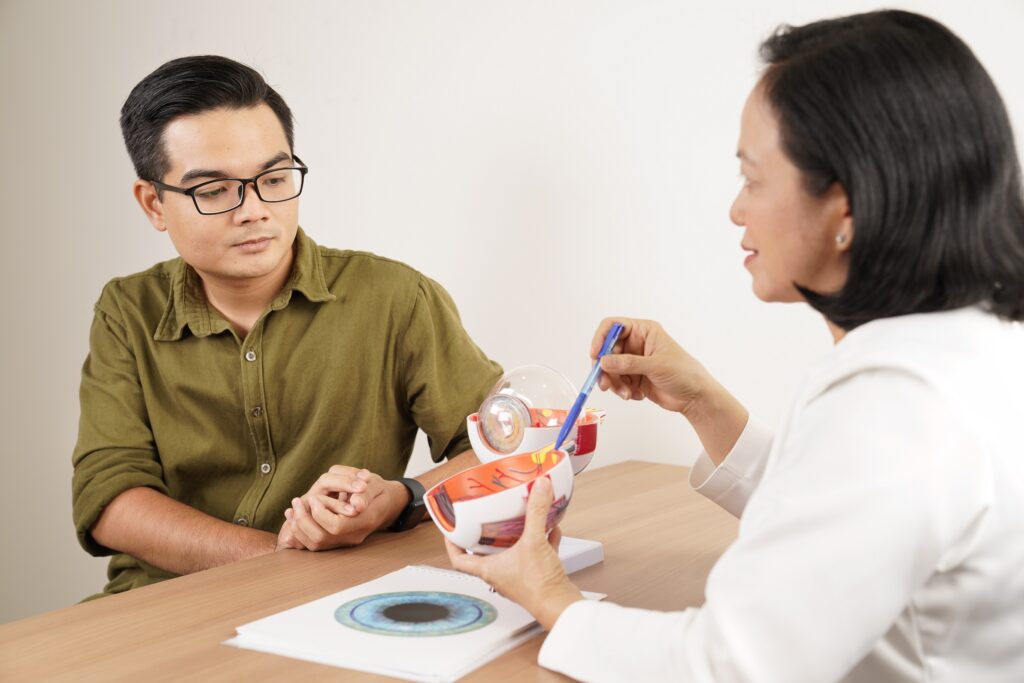
Prima Medical Center Saigon, Refractive and Lasik
Hyperopia – Farsightedness
29 September, 2023
Prima Medical Center Saigon: Farsightedness is one of the most common refractive errors in the eye, the disease manifests itself when the corneal and lens power is too weak, light rays focus behind the retina, making the image blurry.

1. What is farsightedness?
Farsightedness (Hyperopia, Hypermetropia, Farsightedness) is a refractive error in the eye. People with farsightedness have normal vision for long-range targets, but are not clear on close-range targets.
2. Causes of farsightedness
The cause of Hyperopia is that the cornea is flattened or the anterior (posterior) axis of the eyeball is too short, making the image not focus properly on the retina like a normal eye, but focus behind the retina. In this case, a suitable convex lens can help correct the point of focus on the retina.
Severe farsightedness can cause eye strain, headaches, squinting, and even amblyopia. Hyperopia can be corrected with glasses, Lasik surgery, phakic ICL, Phaco IOL monofocal or multifocal lenses.
3. Symptoms and signs of farsightedness
People with farsightedness will sometimes have symptoms such as headaches or eye pain, often squint and feel tired when working at close distances. Even if you wear glasses (frames or contact lenses) but you still feel these marks, you should check your eyes and replace them with new ones.
4. Treatment of farsightedness
Farsightedness can be corrected by wearing glasses or contact lenses that change the focus point of light rays entering the eye. If, after measuring, the prescription begins with a number with a plus sign in front (+2.50), you are farsighted.
When suffering from presbyopia, the patient can choose glasses or contact lenses to read books or when working with computers or working in places with close distances.

Dr Thao consulted a farsightedness patient
People with severe hyperopia should choose aspheric high-index lenses. These lenses will look thinner, lighter, and more compact, and aspherical lenses will also reduce bulging eyes (common with presbyopia).
► Note: High refractive index aspherical lenses reflect more light than standard lenses. Therefore, to achieve high aesthetics and eye comfort, choose lenses with an anti-glare reflective coating, which helps to overcome the disadvantages of conventional aspherical lenses.
Particularly for children, aspherical glass should be made of lightweight and impact-resistant materials.
In addition, people with farsightedness can also be treated by performing Lasik surgery or keratoplasty with radio waves. Surgery not only reduces or completely eliminates the need for glasses to correct hyperopia.
Our Cataract Team
- Dr THAO Vo, Chief Medical Officer , Prima Medical Center Saigon
- Dr AN Trinh, Head of General Ophthalmology
- Dr BINH Tran, Senior Consultant
- Dr TRAN Nguyen, Consultant
Prima Saigon is one of the prestigious eye hospitals in Vietnam, recognized by the US embassy in Vietnam.
If you need an eye assessment, please have a visit to Prima Medical Center Saigon
- Address: 27 Ky Dong St, District 3, HCMC
- Website: https://primahealth.vn/en/
- Business Hours: 07:30 – 17:00 from Monday – Saturday
- HOTLINE: 0919-209-039 or 1900 – 9115
Prima Saigon recommends that clients should reserve their intended consultation at least three days before their visit for convenience and less waiting time.

1. What is farsightedness?
Farsightedness (Hyperopia, Hypermetropia, Farsightedness) is a refractive error in the eye. People with farsightedness have normal vision for long-range targets, but are not clear on close-range targets.2. Causes of farsightedness
The cause of Hyperopia is that the cornea is flattened or the anterior (posterior) axis of the eyeball is too short, making the image not focus properly on the retina like a normal eye, but focus behind the retina. In this case, a suitable convex lens can help correct the point of focus on the retina. Severe farsightedness can cause eye strain, headaches, squinting, and even amblyopia. Hyperopia can be corrected with glasses, Lasik surgery, phakic ICL, Phaco IOL monofocal or multifocal lenses.3. Symptoms and signs of farsightedness
People with farsightedness will sometimes have symptoms such as headaches or eye pain, often squint and feel tired when working at close distances. Even if you wear glasses (frames or contact lenses) but you still feel these marks, you should check your eyes and replace them with new ones.4. Treatment of farsightedness
Farsightedness can be corrected by wearing glasses or contact lenses that change the focus point of light rays entering the eye. If, after measuring, the prescription begins with a number with a plus sign in front (+2.50), you are farsighted. When suffering from presbyopia, the patient can choose glasses or contact lenses to read books or when working with computers or working in places with close distances.
Dr Thao consulted a farsightedness patient
Our Cataract Team
- Dr THAO Vo, Chief Medical Officer , Prima Medical Center Saigon
- Dr AN Trinh, Head of General Ophthalmology
- Dr BINH Tran, Senior Consultant
- Dr TRAN Nguyen, Consultant
- Address: 27 Ky Dong St, District 3, HCMC
- Website: https://primahealth.vn/en/
- Business Hours: 07:30 – 17:00 from Monday – Saturday
- HOTLINE: 0919-209-039 or 1900 – 9115



